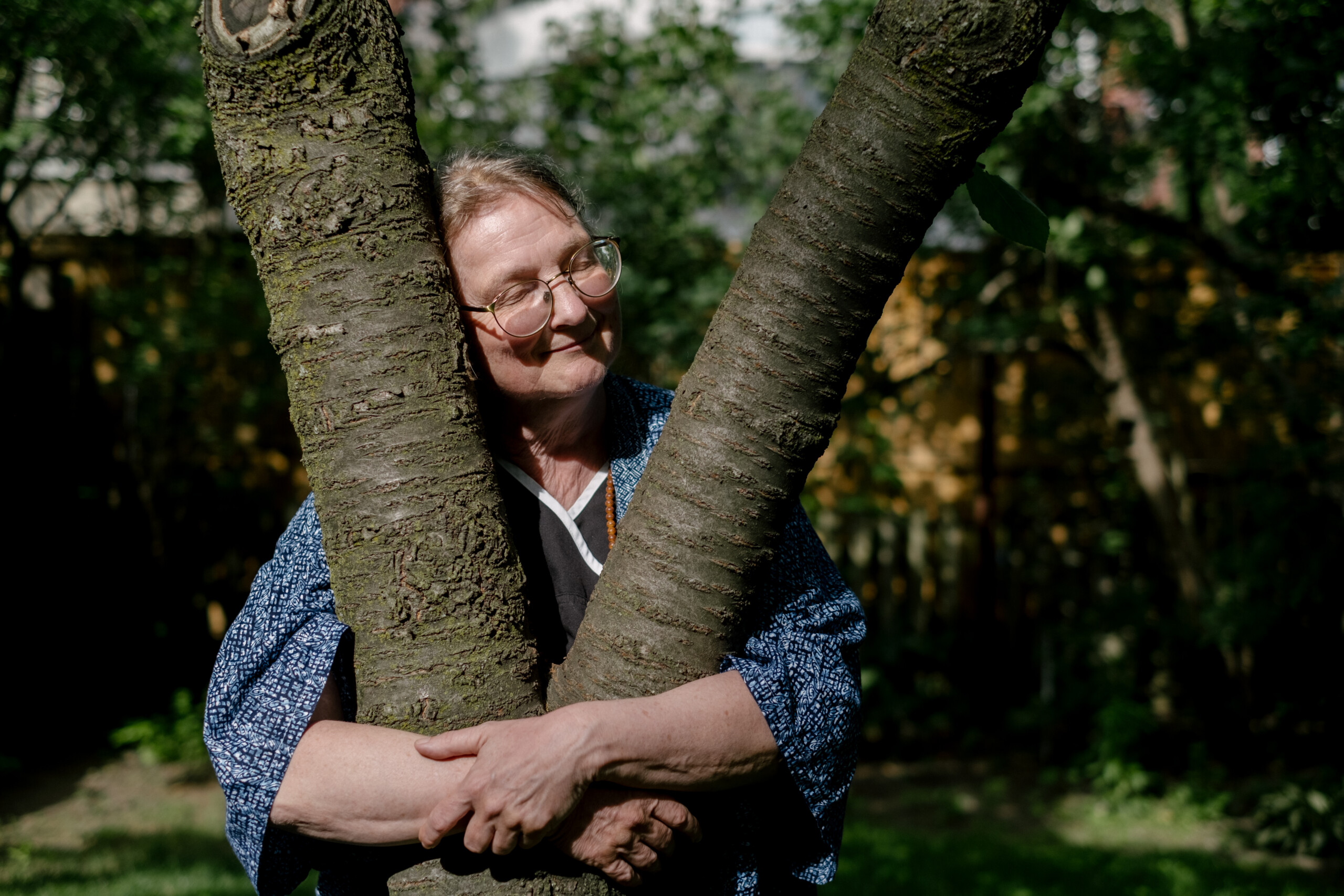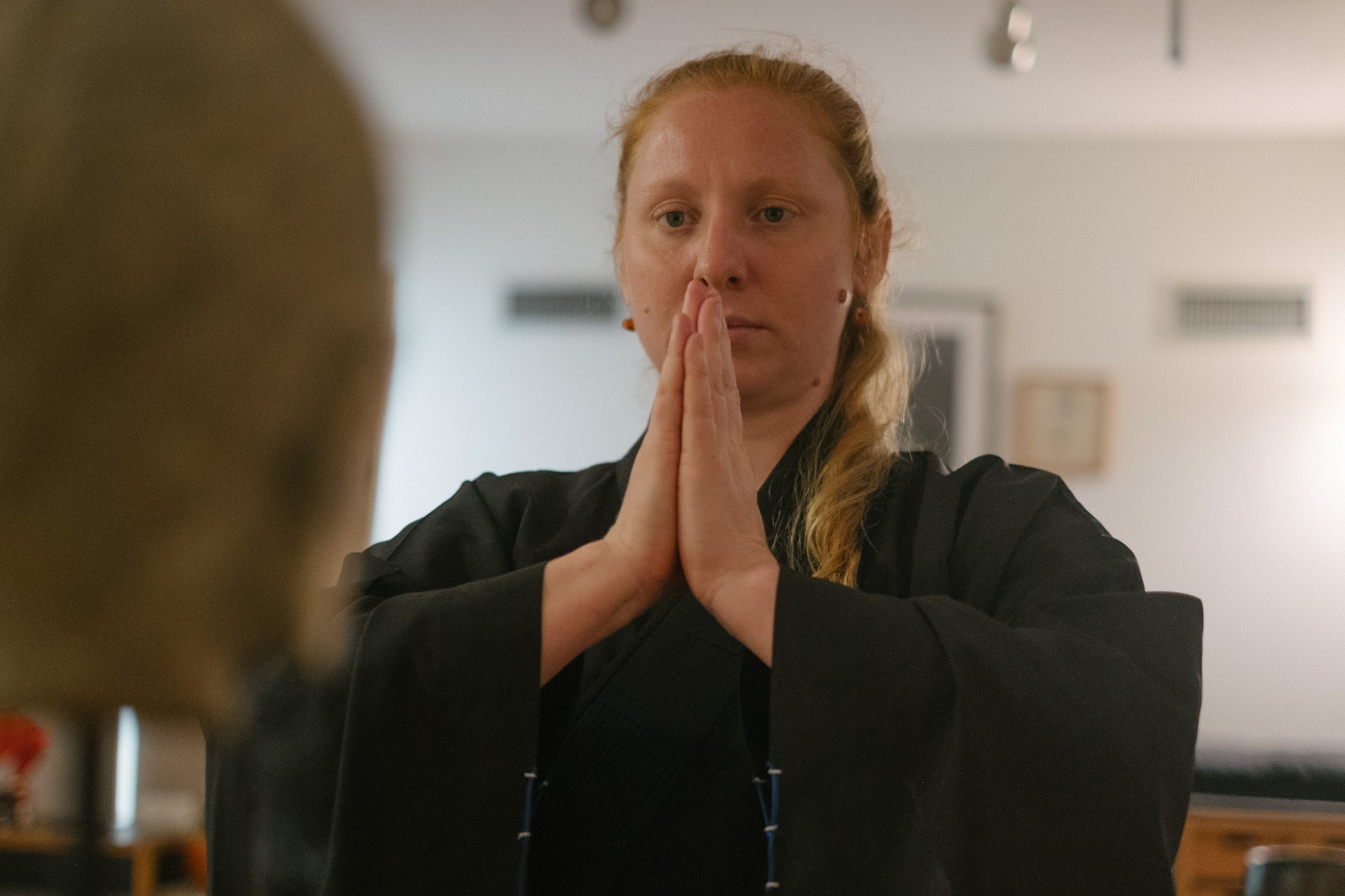Background
Reverend Karen Harrison, born and raised in Canada with roots in Northern Ontario and Ukraine, developed a deep connection to nature during her childhood spent in the woods. Despite having indigenous blood on her father’s side, she felt most spiritually free in the wild, away from the constraints of urban life.
Her spiritual journey took a significant turn during her teenage years when she encountered various influences. On her mother’s side, an independent and artistic aunt inspired her to explore her creativity. Additionally, she had early memories of past lives, contributing to her sense of spiritual awareness. As a teenager, she delved into meditation, initially introduced by Allen Ginsberg, and later explored Zen Buddhism.
In her adult life, Karen became an active peace activist, engaging in anti-nuclear movements and global peace initiatives. Her journey led her to meet various spiritual mentors, including a Tibetan Buddhist Lama and Zen masters. Despite briefly considering becoming a nun, she realized her inclination towards more natural and flexible spiritual practices.
In the late ’70s and early ’80s, Karen’s path intertwined with Thich Nhat Hanh, a Vietnamese Zen master actively involved in international peace efforts. Through their collaboration, Karen learned about the work Thich Nhat Hanh had done in Vietnam, addressing issues like environmental pollution and world hunger. Together, they formed an English-speaking Sangha that combined meditation practice with social justice activism.
Karen continued her engagement in social justice work, collaborating with organizations such as the Community of Reconciliation and contributing to peace initiatives globally. Her involvement with Vietnamese refugees and the anti-apartheid movement further solidified her commitment to social causes.
Karen’s spiritual journey is marked by a balance between meditation practice and social activism, embodying a holistic approach to spirituality and a deep connection to the Earth and its inhabitants.
Discovery
Karen, a teenager with a curious mind, embarked on a spiritual journey influenced by her boyfriend’s passion for insects and animals. A visit to his parents’ house, where she expected to meet a llama, introduced her to a Tibetan Buddhist Lama instead. Despite initial confusion, she found herself engaged in meditation and tea with the Lama, realizing later that he was indeed the spiritual figure she had sought.
Attending a poetry conference in Boulder, Colorado, Karen encountered Allen Ginsberg and delved into meditation under his guidance. Subsequent encounters with Zen masters and her brief contemplation of becoming a nun revealed her inclination for more natural and flexible spiritual practices, avoiding strict rituals.
Karen’s activism in the anti-nuclear movement and global peace initiatives intertwined with her spiritual journey. Collaborating with figures like Thich Nhat Hanh, a Vietnamese Zen master, she found a balance between meditation practice and social justice work. Engaging with Vietnamese refugees and supporting initiatives in Vietnam, Karen’s path evolved, embodying a holistic approach to spirituality and a commitment to making a positive impact on the world.
Activism
As Karen reflects on her evolving activism, she acknowledges a shift in her approach as she embraces a more laid-back attitude. Aging has allowed her to be lazier in her activism, finding confidence in the younger generation’s efforts. Karen encourages and supports these activists while adapting her own methods. Meditation has become integral to her activism, and she recognizes that without it, her efforts may not be as effective.
The passing of Thay, a significant figure in Karen’s life, prompted her to pause all activities and focus solely on her practice. Despite unfolding events in Ukraine, Karen prioritized her meditation practice over immediate activism. Now, her protests involve slow walking, meditation, and moments of stillness. Karen has discovered the power of being fully present in each moment, realizing that subtle resistance, such as stopping and pausing, can be as impactful as traditional forms of protest.
Karen’s approach to activism has become a continuous, meditative resistance in everyday moments. She emphasizes the importance of subtle actions and the power of collective energy, likening it to a river flowing in a particular direction. In her protests, Karen incorporates meditation, acknowledging that the energy and conditions present can shape outcomes without the need for overt actions. Additionally, she has developed a sensitivity to the well-being of fellow protesters, especially elders, using her practice to foresee potential issues and find ways to assist them. Despite ongoing learning, Karen recognizes the profound impact of Tai’s teachings in shaping her approach to both meditation and activism.
Impact
Karen faced a transformative journey, marked by leaving a partner due to alcoholism and embracing a more independent life focused on social justice. Despite societal expectations in the Vietnamese community, she chose to be unmarried and pursued activism and meditation. Engaging with the University of Toronto Buddhist community, Karen organized events, focusing on hunger, homelessness, and poverty, integrating meditation teachings.
Her activism extended to replanting indigenous plants in Hyde Park, incorporating walking meditation. Balancing a demanding schedule, Karen practiced meditation at work, organized meditation sessions at her home for various communities, and facilitated retreats. Despite facing skepticism and misunderstandings about her Buddhist beliefs, Karen’s commitment remained steadfast.
A unique aspect of Karen’s journey involved her advocacy for Buddhist medicine, a holistic approach encompassing meditation, breathing exercises, and nutritional practices. This approach aimed at healing trauma and various conditions, ranging from cancer to arthritis. Despite facing legal challenges due to skepticism about her spiritual leader, Thich Nhat Hanh, Karen persisted in her beliefs, ultimately gaining acknowledgment and support from Prime Minister Justin Trudeau.
Her involvement with a doctor, Dr. Gulati, led to pioneering work on brain changes, exploring neurogenesis and neuroplasticity for brain injuries. Karen’s journey reflects resilience, unwavering faith in Buddhist practices, and a commitment to healing and social justice.
On Activism
But I’ve learned I’ve learned that no matter how hard you protest, you’re just you’re just it’s a river flowing, right? And if the energy is going in that direction and the conditions are right, the conditions that you might want can develop. If you see conditions that are very harmful, you don’t have to do a lot.
Integration
Karen’s journey in Buddhism and activism took a transformative turn when she encountered Thich Nhat Hanh. Previously torn between her activist inclinations and meditation practice, Karen found complete freedom and understanding with Thich Nhat Hanh. Initially engaging in a playful game of hide and seek during walking meditation, their connection transcended conventional boundaries.
In the early days, Karen faced challenges as an activist within the Buddhist community, often concealing her dual identity. The blend of activism and Buddhism was not readily accepted, and she was sometimes perceived as the “activist Buddhist woman.” Despite societal frowns, Karen continued her unique routine of intense meditation, playful activities, and involvement in activism.
The merging of Buddhism and activism was a delicate balance for Karen, as the Buddhist community struggled to fully embrace this integration. However, as Buddhism, especially the Vietnamese lineage, found a more solid foundation, Karen’s dual identity became more accepted. Over time, the once unconventional combination of activism and Buddhism gained greater recognition and understanding within the community.
Hindsight
As Karen reflects on her life, she reminisces about the carefree days of childhood when she was unaware of her sense of self. Over time, societal expectations led her to conform and live according to others’ requirements, prompting a deep exploration of selflessness through Buddhist practice.
In moments of mindfulness, Karen questions the concept of self and strives to channel her energy for the benefit of all beings. Despite occasional failures, she finds profound depth in her practice. A recent encounter at an event, where a person expressed hostility towards her as a Buddhist, exemplifies the challenges she faces. Instead of reacting defensively, Karen skillfully connects with him, dismantling his misconceptions and fostering genuine friendship.
The man’s negative perception of Buddhists, rooted in misconceptions of power and control, gradually transforms through Karen’s patient and compassionate engagement. Thich Nhat Hanh’s mantra, “Are you sure?” guides Karen, highlighting the fallibility of perceptions. She emphasizes the importance of patience and understanding, urging humanity to transcend labels and embrace shared experiences.
Karen envisions a world where mindfulness and compassion, integral to Buddhist teachings, can benefit all humans. She sees Buddhism as a path to a more humane existence, emphasizing the universality of the human experience. In contemplating her own mortality, Karen expresses a wish for her remains to nurture other living beings, echoing the Buddha’s compassionate legacy and selfless sacrifice for the greater good.
Role of Reverend
Karen emphasizes the essence of presence over formal teaching in her approach to sharing wisdom. While acknowledging the challenges of spending extended periods with a teacher, she highlights the enduring nature of the practitioner’s internal teacher. Emphasizing the importance of continued practice, she likens it to polishing, ensuring growth across lifetimes.
Reflecting on her connection to the lineage, Karen underscores the timeless presence of ancestral teachers, like Thich Nhat Hanh, whose teachings resonate even with those who never met him. She contends that the quality of the teacher’s presence matters more than the duration of their physical companionship. Karen suggests that the Dharma, Sangha, and tradition collectively provide refuge and guidance.
In Karen’s view, the teacher isn’t confined to a single person but manifests in various forms, including fellow practitioners. She encourages recognizing the Buddha in everyone, even those with adversarial intentions. The core message is that the true teacher is one whose presence transcends time and space, offering guidance even in the absence of direct interaction. The emphasis lies on the teacher being present rather than the length of time spent with them, fostering a deep and lasting connection with the teachings.
Death and Reincarnation
Karen shares a profound personal experience related to her mother’s passing, expressing a deep connection to the concept of reincarnation. Through meditation practice, she believes that the cells in her body, attuned to somatic memories, contribute to a heightened awareness of rebirth. Karen discusses the physical and cellular closeness she feels to her mother and the unique experiences that validate this connection.
Reflecting on her father’s initial skepticism about Buddhism, she shares a humorous anecdote about introducing him to a retreat, highlighting the transformative power of such practices. Karen emphasizes the acceptance of death and the peace it brings, attributing her confidence to Thich Nhat Hanh’s teachings on dying beautifully. She views death as a transition and believes that the practice equips her to handle emotions and uncertainties associated with it.
Karen also touches on the broader perspective of enlightenment, connecting it to scientific concepts such as light emerging from black holes. She expresses a sense of ease about the end of the Earth and finds solace in the teachings that guide her through life’s uncertainties. In the face of potential global challenges, she emphasizes the role of compassion and communication in preventing harm and fostering understanding.














































































